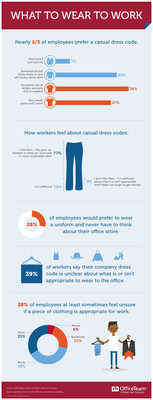Jillian Levick
Senior PR and Communications Manager
Robert Half Canada Inc.,
181 Bay Street, Suite 820,
Toronto, ON
M5J 2T3
www.roberthalf.ca
Press Releases
Read about our latest research, including results from our ongoing surveys of senior managers and workers, and company announcements.

Nearly Two-Thirds of Employees Prefer Casual Office Attire, But Many Unsure of What's Appropriate for the Office
TORONTO, June 19, 2017 /CNW/ - Casual dress codes may cause clothing confusion for many professionals, new research from staffing firm OfficeTeam shows. Although 63 per cent of Canadian workers surveyed said they prefer to wear more relaxed work attire, more than a quarter (28 per cent) admitted they're at least sometimes unsure about whether clothing is office-appropriate. Nearly four in ten (39 per cent) would choose to eliminate uncertainty altogether by donning a uniform.

Workers were asked, "Which office dress code do you prefer?" Their responses:
|
Very formal (suit and tie) |
7% |
|
Somewhat formal (dress slacks or skirt with button-down shirt) |
30% |
|
Somewhat casual (khakis and polo shirt or sweater) |
36% |
|
Very casual (jeans and T-shirt) |
27% |
|
100% |
Additional findings:
- Those ages 18 to 34 (45 per cent) have the greatest preference for formal dress codes. They're also most commonly unsure if their clothing is appropriate (36 per cent) and the age group with the largest number of respondents interested in wearing a uniform (33 per cent).
- More men (49 per cent) prefer formal attire than women (25 per cent).
- Most employees (77 per cent) reported they like casual dress codes because they can wear more comfortable clothing.
- About two in five respondents (39 per cent) said their company policy isn't always clear about what attire is acceptable.
Employees were also asked to reveal something they've considered wearing to work but were unsure whether it was appropriate. Here are some of their responses:
- An off-the-shoulder ("cold shoulder") top
- Cowboy boots
- Band T-shirt
- Funky Socks
- Jogging pants
- Leggings
- Flip-flops
- A baseball hat
- Jeans
- Running shoes
- Camo Pants
- A hoodie
- A low-cut top
- Capri pants
- Mini skirt
- Dressy sandals
- A sports jersey
- Shorts
- A polo shirt
- Yoga pants
- A tank top
- A sheer top
- Ripped Jeans
"Non-traditional workplaces are becoming more common, creating demand for greater flexibility with hours, remote work options and attire. When it comes to dress codes, it's important that employees have clarity," said Koula Vasilopoulos, a district president for OfficeTeam. "Managers should clearly articulate standards for what is appropriate; formally through corporate policies, and informally, leading by example through their own attire. With their guidance, employees will be able to make clothing choices that showcase their confidence and professionalism."
About the Research
The survey was developed by OfficeTeam and conducted by an independent research firm. It includes responses from more than 430 Canadian workers 18 years of age or older and employed in office environments.
About OfficeTeam
OfficeTeam, a Robert Half company, is the nation's leading staffing service specializing in the temporary placement of highly skilled office and administrative support professionals. The company has 300 locations worldwide. For additional information, visit roberthalf.ca/officeteam. Follow @RobertHalf_CAN on Twitter and the OfficeTeam Take Note® blog at roberthalf.com/officeteam/blog for career and management advice.
OfficeTeam
181 Bay Street, Suite 820
Toronto, ON M5J 2T3
Contact: Naz Araghian
416.865.2140
naz.araghian@roberthalf.com
SOURCE OfficeTeam
